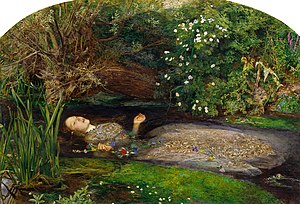Ophelia (painting)

|
| Ophelia |
|---|
| John Everett Millais , 1851-1852 |
| Oil on canvas |
| 76.2 x 111.8 cm |
| Tate Britain |
Ophelia is a painting by John Everett Millais that was completed in 1852 . It depicts the character of the same name from Shakespeare's tragedy Hamlet floating in a river just before she drowns. In the play this is described in the speech (act 4, scene 7) by Hamlet's mother Gertrude.
- A willow tree leans over the brook
- And shows its gray leaves in the clear stream,
- With which she wreathed wreaths fantastically
- From Hahnfuß, nettles, Maßlieb, cuckoo flowers.
- There when it came up, around its leaf thread
- To hang on the lowered branches,
- Broke a false branch and fell down
- The climbing trophies and herself
- Into the weeping waters. Her clothes
- Spread widely and carried them
- Sirens up for a while,
- While she sang passages of old sages
- As if she didn't understand her own need
- Like a creature, born and gifted
- For this element. But it doesn't last long
- Until her clothes, which are hard drunk,
- The poor child of their melodies
- Pulled down into muddy death.
The painting was made by Millais in two steps: first he painted the landscape on site and then the figure of Ophelia in the studio. While painting in nature, Millais had some difficulties. In a letter to a friend, he reported the harassment by mosquitoes, a summons before the magistrate for trespassing on a field and destroying hay, and the risk of being blown into the water by a gust of wind. When it finally began to storm and snow in November 1851, Millais had a straw hut built for her.
In the winter of 1851/52 Millais then added the figure of Ophelia in his studio (7 Gower Street, London). The model for Ophelia was the artist Elizabeth Eleanor Siddal . She posed for the picture fully clothed in a bathtub, but caught a bad cold as a result: Millais was so busy with his work that he forgot to replace the candles that were under the tub and kept the water warm. Her father threatened him with legal action until he agreed to pay the medical bill.
The picture is known for its detailed depiction of the vegetation of the river and the bank, which symbolizes the growth and decay in nature. Despite the actually Danish setting, the landscape can essentially be viewed as English. The picture was painted on the banks of the River Hogsmill near Tolwort, near London. Barbara Webb, a resident of nearby Old Malden , spent a lot of time looking for the exact location of the picture. According to their research, it is Six Acre Meadow , off Church Road, Old Malden. The painter William Holman Hunt , who was close to Millais, was working on his work The Hired Shepherd at the same time very close by.
The flowers that swim with Ophelia in the river were chosen according to Shakespeare's instructions for Ophelia's flower garland. But they also reflect the widespread interest in the language of flowers in Victorian times , according to which every flower has a symbolic meaning. The common poppy , not mentioned by Shakespeare, represents sleep and death. Ophelia's pose, arms open and staring at the sky, is reminiscent of traditional portraits of saints or martyrs, but can also be interpreted erotically. Millais' Ophelia hangs out at Tate Britain , London.
